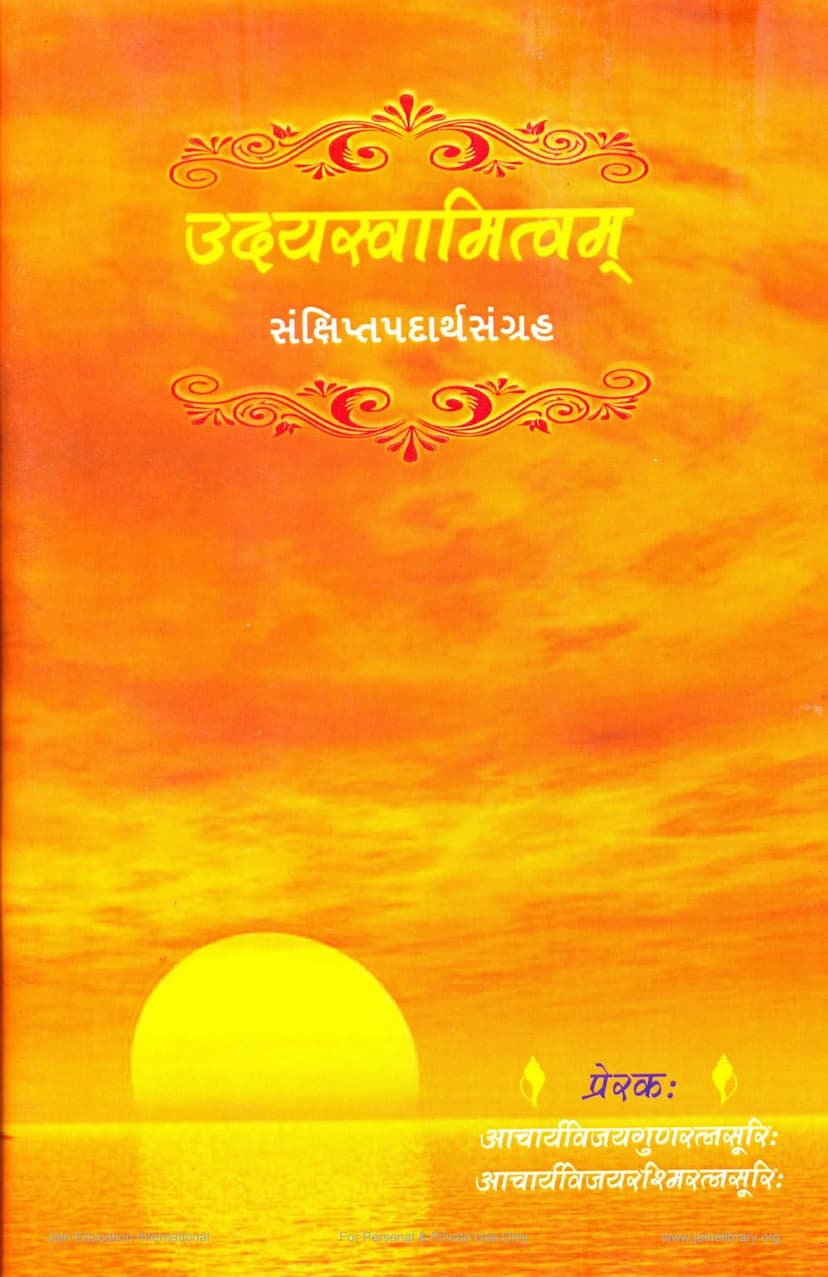Udayswamitvam
Added to library: September 2, 2025

Summary
The book "Udaysvamitva Sankshipt Padarth Sangrah" (उदयस्वामित्व संक्षिप्त पदार्थ संग्रह), authored by Muni Yashratnavijayji, inspired by Acharya Vijay Gunratnasurishwarji and Acharya Vijay Rashmiratnasurishwarji, and published by Jin-gun Aradhak Trust, is a concise summary of the Jain text 'Udaysvamitva'.
Core Subject:
The book meticulously details which karmic dispositions (karma prakritis) are in a state of 'udaya' (manifestation or fruition) for beings in different stages of spiritual development (gunasthanas) across sixty-two classifications of existence (marganas). In essence, it answers the question: "For which beings, and at which spiritual stages, do specific karmic potentials manifest?"
Key Features and Content:
-
Based on 'Udaysvamitva': The primary source text is 'Udaysvamitva', originally authored by Acharya Vijay Gunratnasurishwarji. This book serves as a simplified and condensed version for easier understanding.
-
Sixty-Two Marganas: The study covers sixty-two distinct categories or pathways of existence, such as:
- Gati (States of Existence): Hellish beings, celestial beings, sub-human beings (animals), and humans.
- Indriya (Sense Faculties): Beings with one, two, three, four, or five sense faculties.
- Kaya (Bodies): Earthly, watery, fiery, airy, plant, and mobile beings.
- Yoga (Activity): Mental, verbal, and bodily activities.
- Veda (Gender/Disposition): Masculine, feminine, and neuter dispositions.
- Kashaya (Passions): Anger, pride, deceit, and greed.
- Gyan (Knowledge): Various types of knowledge and ignorance.
- Sanyam (Restraint): Different levels of spiritual restraint.
- Darshan (Perception): Different types of perception.
- Leshya (Color Dispositions): Karmic color classifications (black, blue, grey, yellow, red, white).
- Bhavya/Abhavya (Potential for Liberation): Beings with or without the potential for liberation.
- Samyaktva (Right Faith): Stages of right faith.
- Sanjni/Asanjni (Sentient/Non-sentient): Classification based on mental activity.
- Aahary (Ingestion): Beings who ingest and those who do not.
-
Gunsthanas (Spiritual Stages): The book analyzes the manifestation of karmas across all fourteen spiritual stages, from the initial stage of utter delusion (mithyatva) to the stage of omniscience (kevalgyan).
-
Detailed Analysis: For each margana, the book systematically lists which karmic dispositions are:
- In Udaya (Manifesting): The karmas that are currently active.
- In Anudaya (Not Manifesting, but can reappear): Karmas that have ceased to manifest in the current stage but might reappear in a later stage.
- In Udaya Vicched (Ceased Manifestation): Karmas that have ceased to manifest and will not reappear in higher stages.
- Punarudaya (Re-manifestation): Karmas that re-emerge after a period of 'anudaya'.
-
Structure: The book provides a systematic breakdown, starting with:
- Mangalacharan (Invocation): A prayer to Lord Virjinendra and the Gurus.
- Pithika (Introduction): Explaining the concept of 'udaya' and outlining the scope of the work.
- Explanation of Key Concepts: Defining terms like 'anudaya', 'udaya vicched', and 'punarudaya'.
- Prakriti Sangrah (Collection of Karmic Dispositions): A list of all karmic dispositions for reference.
- Detailed Margana-wise Analysis: Presenting the manifestation of karmas for each of the sixty-two marganas in relation to the fourteen gunasthanas. This forms the bulk of the book.
- Parishisht (Appendix): Including the original verses (gathas) and their meanings from the 'Udaysvamitva' text.
-
Practicality and Accessibility: The intention behind this "Sankshipt Padarth Sangrah" is to make the complex subject of 'Udaysvamitva' accessible for study, especially for evening recitations ('ratri-swadhyay') and for those with a concise interest. It highlights the practical application of these principles in understanding the karmic journey of the soul.
-
Authoritative Sources: The compilation acknowledges the influence and guidance of prominent Jain scholars and texts, including works like 'Panch Sangrah Vivechan', 'Karmastav Vivechan', and 'Karma Granth'.
Overall Significance:
"Udaysvamitva Sankshipt Padarth Sangrah" is a vital resource for Jain scholars, monks, and serious lay followers interested in the intricate workings of karma as explained in Jain philosophy. It provides a clear and organized framework for understanding the dynamic nature of karmic manifestation throughout the spiritual journey of the soul. The book's focus on tabulation and concise explanations makes the profound principles of 'Udaysvamitva' more readily available for contemplation and study.